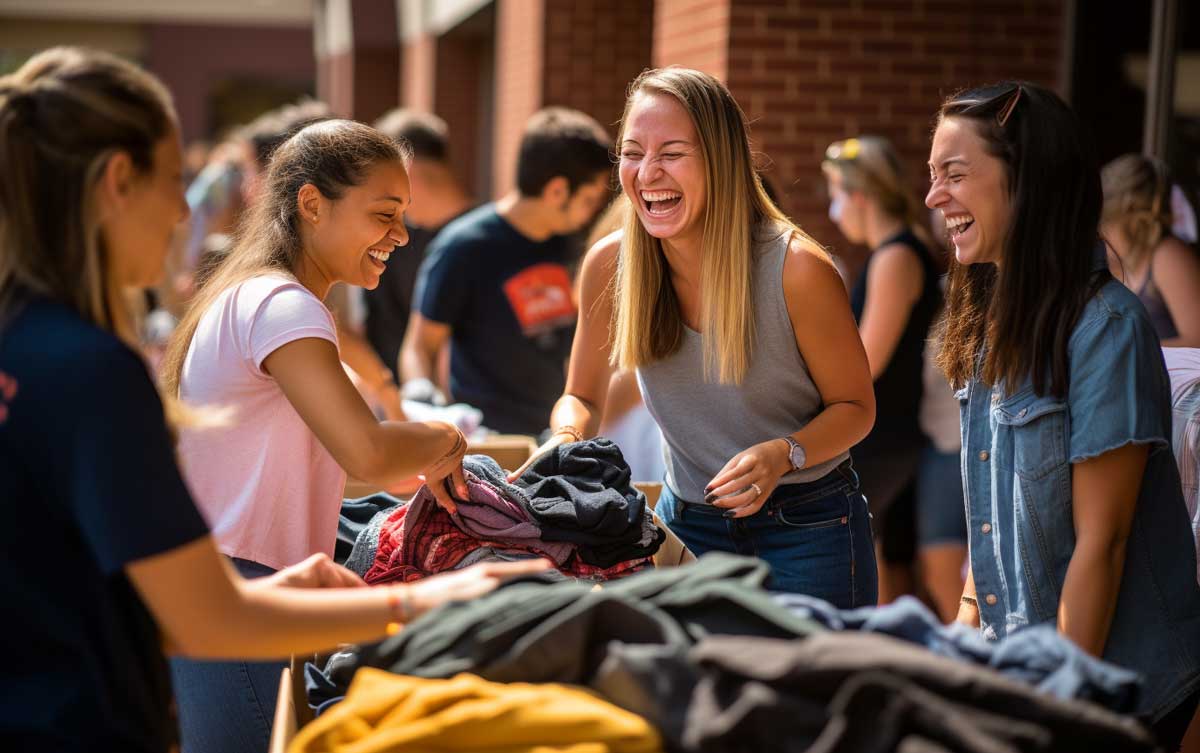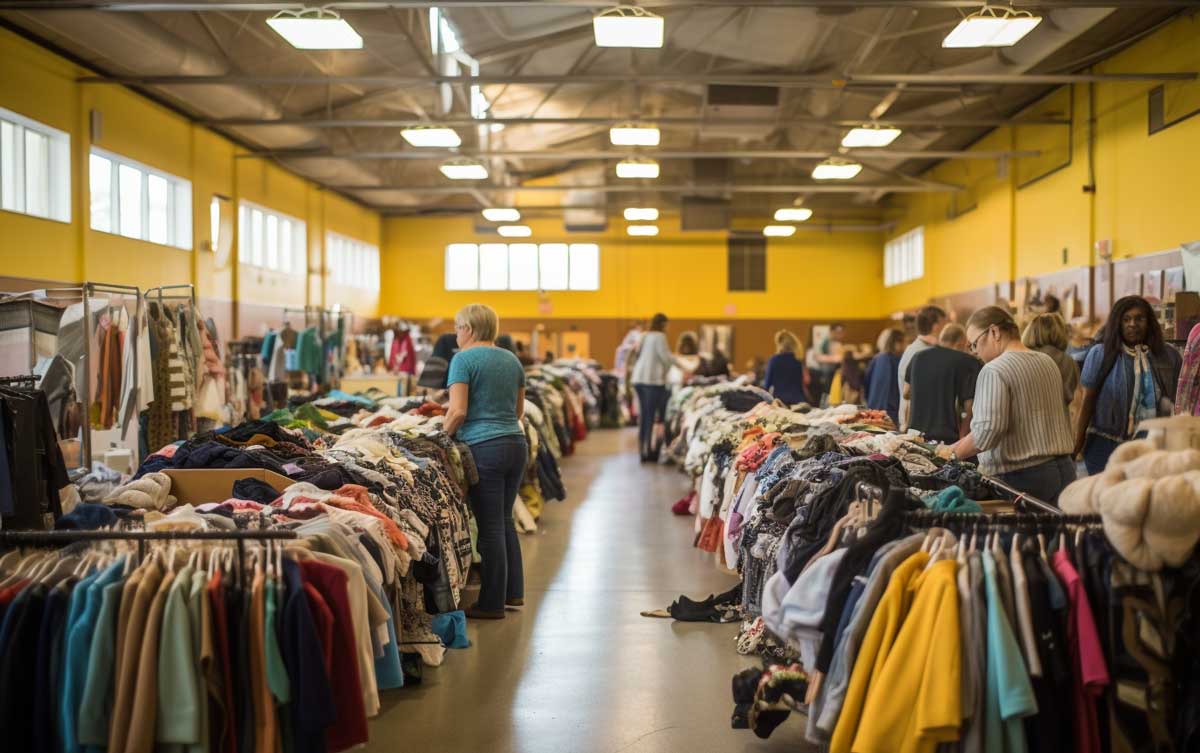Clothing vouchers, offered by non-profits like the Salvation Army, provide essential support for financially distressed adults. Covering a range of attire, from daily wear to specialized items, recipients must demonstrate financial need.
Once eligible, they redeem vouchers at specific outlets, choosing suitable sizes and styles. More than just clothing, these vouchers bolster confidence, assist in societal integration, and often form part of holistic assistance, symbolizing empowerment and a step towards self-reliance.
Types of Available Clothing Vouchers
Clothing vouchers, tailored for diverse needs, offer pivotal support to financially constrained adults seeking essential attire. Key vouchers include:
-
Seasonal Clothing Vouchers: Issued in varying weather conditions, these vouchers cater to seasonal attire needs, such as winter coats during cold spells or summer wear during warmer periods.
-
Professional Attire Vouchers: Recognizing the significance of appropriate workplace attire, these vouchers facilitate the acquisition of business essentials like suits, dress shirts, and skirts for job-related events.
-
Shoe Vouchers: Going beyond clothing, these ensure recipients get proper footwear, prioritizing comfort, safety, and functionality.
-
Maternity Clothing Vouchers: Supporting expectant mothers, these vouchers cater to their unique clothing requirements during pregnancy.
-
Thrift Store Vouchers: Promoting affordability and sustainability, these allow beneficiaries to opt for gently-used garments at discounted prices.
It's vital to understand that voucher availability and specifics hinge on the assisting organization's policies and funding. These vouchers, while addressing immediate clothing concerns, also uplift recipients' confidence and societal engagement.
Need for Clothing Vouchers
In today's socio-economic climate, numerous individuals and families grapple with fulfilling fundamental needs, prominently clothing. Clothing vouchers emerge as vital lifelines, ensuring access to essential attire corresponding to seasonal, professional, or specialized requirements.
These vouchers address precise needs, from winter essentials ensuring warmth, to professional clothing enhancing job prospects. Moreover, demographics-specific vouchers, like maternity ones, cater to distinct challenges, ensuring pregnant individuals receive apt attire. Furthermore, thrift store vouchers present an economical solution amidst escalating living costs, enabling recipients to procure gently used clothing affordably.
These vouchers originate from charitable organizations and community centers, pivotal in narrowing the disparity between resources and individual needs. They champion an equitable society, guaranteeing clothing access irrespective of economic standings.
In sum, clothing vouchers are indispensable, catering to crucial needs spanning seasons, professions, and specific circumstances. To optimize this support, individuals must engage with local charities, ensuring they're equipped with attire essential for well-being and confidence.
Benefits to Low-Income Families
Low-income families face multifaceted challenges, from securing basic necessities to ensuring their children's well-being. To address this, several benefits are available: financial assistance covers fundamental needs, while clothing vouchers ensure dignified attire choices.
Support extends to educational supplies for children, promoting academic achievements. Rental aid prevents homelessness, ensuring stable living conditions. Critical healthcare services are made accessible, safeguarding against daunting costs. Moreover, job and educational training fortify skills, enhancing employability and financial futures. Together, these benefits significantly uplift struggling families, highlighting the importance of continued community support.
Reasons Why Adults Need Assistance with Clothing
Clothing, beyond its fundamental protective function, influences one's self-image and societal interactions. For adults grappling with economic constraints, acquiring suitable attire can pose challenges. Clothing vouchers and assistance programs emerge as essential aids for several reasons.
-
Many, after addressing core expenses like rent and food, lack resources for clothing.
-
Attire aligns with professional opportunities; the right outfit can bolster one's prospects during job interviews.
-
Seasonal clothing, especially winter gear, is essential but can strain budgets.
-
Expectant mothers face unique wardrobe demands, making maternity clothing assistance invaluable.
-
Moreover, attire intertwines with personal and professional aspirations, and suitable clothing can boost confidence in academic or job settings.
-
Finally, unforeseen calamities like house fires or job losses can eradicate personal possessions, underlining the significance of emergency clothing assistance.
Clothing support for financially-strapped adults isn't merely about attire; it's a step towards elevating their overall life quality.
Impact on Mental Health and Self-Confidence
Clothing assistance programs profoundly influence mental health and self-worth. Beyond mere attire, clothing is pivotal for self-expression and personal representation, directly shaping confidence. The inability to access appropriate clothing can erode mental well-being, making individuals feel marginalized or diminished.
These programs not only restore dignity but also empower personal expression and social ease. Appropriate attire for professional settings enhances one's self-assurance, potentially catalyzing professional accomplishments and fostering financial stability, which in turn elevates mental health. Moreover, by democratizing access to clothing, these initiatives foster community inclusivity, ensuring everyone feels valued, connected, and mentally supported.
Thus, clothing assistance is not just about garments; it's a catalyst for enhanced self-esteem, societal inclusion, and holistic well-being. Ensuring everyone can dress appropriately bolsters not only individual pride but also cultivates a more empathetic, inclusive society.
Where to Find Clothing Vouchers
In times of financial strain, sourcing affordable clothing becomes daunting. Numerous organizations and initiatives provide clothing vouchers, aiding individuals and families in distress. Renowned non-profits like the Salvation Army and Catholic Charities offer vouchers redeemable at their outlets, ensuring access to budget-friendly attire while cementing community bonds.
Local social service hubs and community centers also distribute such vouchers, bolstering the local economy and providing essential clothing. Schools often dispense vouchers for uniforms or regular attire, ensuring students are adequately clothed. Community organizations and religious establishments might offer or guide to assistance schemes.
While availing of vouchers, one must present relevant income documentation, ensuring eligibility. Conclusively, an array of sources offers clothing assistance. Tapping into these ensures not just financial relief but also the empowering effect of appropriate attire. Explore local resources if you, or anyone known, requires clothing aid.
Salvation Army
The Salvation Army stands as an esteemed non-profit, offering myriad services to the underserved, prominently including their clothing voucher program. This initiative ensures eligible recipients access affordable, diverse clothing options from their thrift stores.
These outlets, replete with attire for all, are priced lower than mainstream retail, catering to budget-conscious individuals. The Salvation Army doesn’t just furnish clothing relief; it also cultivates community solidarity. Staffed by devoted volunteers, its thrift shops channel contributions directly into community aid.
Moreover, they render extensive assistance encompassing financial support, food aid, job training, and urgent relief. Those seeking clothing vouchers must present relevant financial documentation, with criteria varying by location. To encapsulate, the Salvation Army's program offers a lifeline for affordable clothing, while its broader services and thrift stores empower communities, ensuring universal access to essential attire.
Non-Profit Organizations
Non-profit organizations are indispensable pillars in confronting societal challenges, primarily operating for public welfare over shareholder profits. A prime example is the Salvation Army, which renders multifaceted services, notably clothing assistance. These entities thrive on magnanimous donations and voluntary efforts.
Their mandate spans addressing acute issues like poverty, hunger, and healthcare, aiming for profound societal transformation. Beyond service delivery, they're instrumental in advocacy, championing social justice and sustainability, often influencing policy shifts. Collaboration with other sectors amplifies their impact, fostering resource pooling and unified endeavors against societal intricacies.
Governed by a board and strict regulations, they uphold financial transparency and accountability, necessitating annual report submissions to retain stakeholder trust. Conclusively, non-profits are pivotal in reshaping individual lives and entire communities. Their endeavors, from offering clothing to educational support, lean on collective backing, enabling a more inclusive and empathetic society.
Charitable Run Clothing Banks
Charitable clothing banks, primarily non-profit, provide crucial clothing assistance to financially distressed individuals. Relying on dedicated volunteers, they collaborate with large non-profits like the Salvation Army to enhance their reach. While they offer a range of attire, access often requires evidence of genuine need.
Beyond apparel, they extend holistic support, such as job training. Given the consistent high demand, community contributions through donations and volunteering are essential. By endorsing these banks, communities manifest tangible compassion and inclusivity.
Thrift Stores and Vouchers
Operated largely by charitable organizations, thrift stores offer crucial aid to those facing financial hardships. Thrift store vouchers, distributed by community partners, allow recipients to acquire clothing and essentials, promoting dignity and choice.
Beyond clothing, these stores provide household necessities, embodying sustainability through reuse and public donations. Thus, supporting thrift stores reinforces communal ties and fosters sustainable consumption.
Online Resources
The digital age has transformed how individuals access clothing vouchers and assistance. With the convenience of online platforms, seekers can effortlessly access detailed information from non-profits and agencies.
This digital accessibility ensures even those in remote locations can obtain aid. Additionally, these platforms foster community, enabling individuals to share experiences and advice. In sum, online resources simplify assistance procurement while nurturing supportive digital communities, empowering individuals on their path to improvement.
Eligibility Requirements for Clothing Vouchers
Clothing vouchers, facilitated primarily by nonprofits and charitable agencies, cater to those lacking the financial means to secure clothing. However, acquiring these requires meeting certain prerequisites:
-
Financial Need: Proof such as pay stubs, tax returns, or evidence of government support typically verifies this.
-
Specific Life Events: Events like job loss, illness, or disasters can enhance eligibility.
-
Special Groups: Some prioritize veterans, the elderly, or single parents.
-
Residency Constraints: Certain programs might restrict assistance to locals of a specific area, ensuring the focus remains on targeted communities.
-
Frequency of Aid: Organizations might limit how often one can access vouchers (e.g., monthly or annually), ensuring equitable distribution.
Prospective beneficiaries should meticulously scrutinize each organization's criteria, usually available online or upon direct inquiry. For optimal clarity, individuals should contact organizational representatives. Understanding and satisfying these prerequisites ensures timely, valuable assistance with suitable attire.
Proof of Income Requirements
Applying for clothing vouchers often necessitates proof of income, enabling organizations to gauge financial need. Commonly accepted proofs include:
-
Pay Stubs: Displays monthly earnings and affirms current income.
-
Government Assistance: Documents of unemployment benefits or welfare.
-
Tax Returns: Useful for freelancers or the self-employed, depicting annual earnings.
-
Unconventional Income: Income from rental properties, investments, or child support requires supporting documents like rental agreements or bank statements.
-
Life Events: Changes such as job loss or medical issues might require further documentation like medical bills or termination letters.
Applicants uncertain about document requirements should consult the offering organization. Preparing these documents in advance facilitates a smoother process, signaling readiness to receive aid.
Age Restrictions and Clothing Vouchers
Understanding age restrictions is paramount when seeking clothing vouchers:
-
Adult Focus: Many programs target adults, acknowledging their responsibility in supporting families and their unique financial challenges.
-
Research: Identifying local programs and understanding their criteria is vital. Entities like non-profits or thrift stores might have age-specific guidelines.
-
Specialized Programs: Some organizations might cater specifically to seniors or certain age groups, recognizing unique needs.
-
Application: Besides other documents, age verification might be mandatory.
If age criteria aren't met, explore alternative avenues. Understanding these restrictions ensures that vital resources reach the most in need.
FAQs
1. What criteria determine eligibility for financial assistance programs for low-income families?
Eligibility typically depends on family size, income level, and specific program guidelines, which vary by organization and region.
2. How can one apply for clothing vouchers?
Applications are usually available through specific non-profit organizations, either online or at their physical locations.
3. Are there specialized programs that solely focus on children's educational needs?
Yes, several organizations specifically cater to children's educational supplies, ensuring they have the tools for academic success.
4. Do rental assistance programs cover the full rent or only a portion?
This varies. Some programs may cover full rent for a limited period, while others might subsidize a portion based on the family's financial situation.
5. How does one find local job and educational training programs?
Local community centers, non-profits, and government websites often provide information on available training opportunities in the region.
Conclusion
Supporting low-income families transcends mere financial aid; it's about nurturing potential, safeguarding well-being, and empowering futures. By understanding the available benefits and how to access them, families can leverage these tools for betterment, underscoring the collective role we play in fostering resilient communities.
Read more about clothing assistance options low income folks can explore from our blogs at Gov-Relations.







